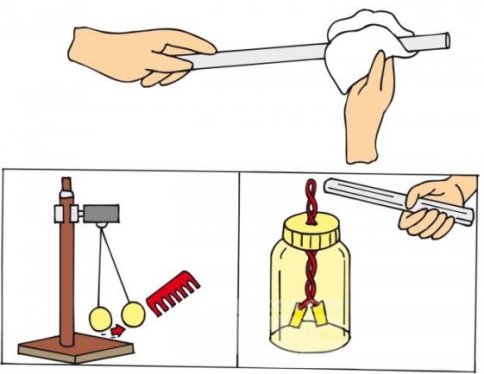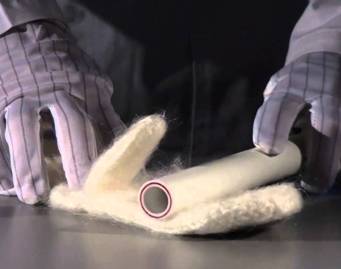Electrification of bodies, interaction of charges
In this article, we will try to present a fairly generalized idea of what the electrification of bodies is, and we will also touch on the law of conservation of electric charge.
Regardless of whether this or that source of electrical energy works for the principle, each of them electrification of physical bodies takes place, that is, the separation of electrical charges present in the source of electrical energy and their concentration in certain places, for example, on the electrodes or terminals of the source. As a result of this process, an excess of negative charges (electrons) is obtained at one terminal of the source of electrical energy (cathode), and a lack of electrons at the other terminal (anode), i.e. the first of them is charged with negative electricity, and the second with positive electricity.
After the discovery of the electron, the elementary particle with minimal charge, after the structure of the atom was finally explained, most physical phenomena related to electricity also became explainable.
The material matter that makes up the bodies is generally found to be electrically neutral, since the molecules and atoms that make up the body are neutral under normal conditions, and the bodies consequently have no charge. But if such a neutral body rubs against another body, then some of the electrons will leave their atoms and pass from one body to another. The length of the paths traveled by these electrons during such movement is no more than the distance between neighboring atoms.
However, if after friction the bodies separate, move apart, then both bodies will be charged. The body to which the electrons have passed will become negatively charged, and the one that donated these electrons will acquire a positive charge, will become positively charged. This is electrification.

Suppose that in some physical body, for example in glass, it was possible to remove some of their electrons from a significant number of atoms. This means that the glass, which has lost some of its electrons, will be charged with positive electricity, because in it the positive charges have gained an advantage over the negative ones.
The electrons removed from the glass cannot disappear and must be put somewhere. Assume that after the electrons are removed from the glass, they are placed on a metal ball. It is then obvious that the metal ball that receives additional electrons is charged with negative electricity, since in it negative charges are given priority over positive ones.
Electrify the physical body — means to create in it an excess or lack of electrons, i.e. disturb the balance of two opposites in it, namely positive and negative charges.
To electrify two physical bodies simultaneously and together with different electric charges — means to withdraw electrons from one body and transfer them to another body.
If a positive electric charge has formed somewhere in nature, then a negative charge of the same absolute value must inevitably arise simultaneously with it, since any excess of electrons in any physical body arises due to their lack in some other physical body.
The various electric charges appear in electrical phenomena as invariably accompanying opposites, whose unity and interaction constitute the internal content of electrical phenomena in substances.

Neutral bodies become electrified when they give or receive electrons, in either case they acquire an electric charge and cease to be neutral. Here the electric charges do not arise from nowhere, the charges are only separated, because the electrons were already in the bodies and simply changed their location, the electrons move from one electrified body to another electrified body.
The sign of the electric charge resulting from the friction of bodies depends on the nature of these bodies, on the condition of their surfaces, and on a number of other reasons. Therefore, the possibility is not excluded that the same physical body in one case is charged with positive and in another with negative electricity, for example, metals when rubbed against glass and wool become negatively electrified, and when rubbed against rubber — positively.
An appropriate question would be: why does electric charge not flow through dielectrics but through metals? The point is that in dielectrics all the electrons are bound to the nuclei of their atoms, they just don't have the ability to move freely throughout the body.
But in metals the situation is different. Electron bonds in metal atoms are much weaker than in dielectrics, and some electrons easily leave their atoms and move freely throughout the body, these are the so-called free electrons that provide charge transfer in wires.
Separation of charges occurs both during friction of metallic bodies and during friction of dielectrics. But in demonstrations, dielectrics are used: ebonite, amber, glass. This is resorted to for the simple reason that since the charges do not move through the volume in dielectrics, they remain in the same places on the surfaces of the bodies from which they arose.

And if by friction, say, for the fur, a piece of metal becomes electrified, then the charge, which only has time to move to its surface, will instantly drain onto the body of the experimenter, and a demonstration, for example, with dielectrics, will not work. But if a piece of metal is isolated from the hands of the experimenter, it will remain on the metal.
If the charge of the bodies is released only in the process of electrification, then how does their total charge behave? Simple experiments provide an answer to this question. Taking an electrometer with a metal disk attached to its rod, place a piece of woolen cloth over the disk, the size of that disk. On top of the tissue disc is placed another conductive disc, the same as on the electrometer rod, but equipped with a dielectric handle.
Holding the handle, the experimenter moves the upper disk several times, rubs it against said tissue disk lying on the disk of the electrometer rod, then moves it away from the electrometer. The needle of the electrometer deflects when the disc is removed and remains in that position. This indicates that an electric charge has developed on the woolen fabric and on the disk attached to the electrometer rod.
The disc with the handle is then brought into contact with the second electrometer, but without the disc attached to it, and its needle is observed to be deflected by nearly the same angle as the needle of the first electrometer.
The experiment shows that both disks during electrification received charges of the same module. But what are the signs of these accusations? To answer this question, electrometers are connected by a wire. The needles of the electrometer will immediately return to the zero position each in which they were before the experiment began. The charge was neutralized, meaning that the charges on the disks were equal in magnitude but opposite in sign, and overall gave zero, as before the experiment began.
Similar experiments show that during electrification, the total charge of bodies is conserved, that is, if the total amount was zero before electrification, then the total amount will be zero after electrification... But why does this happen? If you rub an ebony stick on a cloth, it will become negatively charged and the cloth positively charged, and this is a well-known fact. An excess of electrons is formed on ebonite when rubbed on wool, and a corresponding deficit on cloth.
The charges will be equal in modulus, because how many electrons have passed from the cloth to the ebonite, the ebonite has received such a negative charge, and the same amount of positive charge has formed on the canvas, because the electrons that have left the cloth are the positive charge on the cloth. And the excess of electrons on the ebonite is exactly equal to the lack of electrons on the cloth. The charges are opposite in sign but equal in magnitude. Obviously, full charge is conserved during electrification; it is equal to zero in total.
Moreover, even if the charges on both bodies were non-zero before electrification, the total charge is still the same as before electrification. Having denoted the charges of the bodies before their interaction as q1 and q2, and the charges after the interaction as q1' and q2', then the following equality will be true:
q1 + q2 = q1 ' + q2'
This implies that for any interaction of bodies the total charge is always conserved. This is one of the fundamental laws of nature, the law of conservation of electric charge. Benjamin Franklin discovered it in 1750 and introduced the concepts of "positive charge" and "negative charge". Franklin and proposed to indicate opposite charges with «-» and «+» signs.
In electronics Kirchhoff's rules because currents follow directly from the law of conservation of electric charge. The combination of wires and electronic components is represented as an open system. The total inflow of charges into a given system is equal to the total outflow of charges from that system. Kirchhoff's rules assume that an electronic system cannot significantly change its total charge.
In fairness, we note that the best experimental test of the law of conservation of electric charge is the search for such decays of elementary particles that would be allowed in the case of non-strict conservation of charge. Such decays have never been observed in practice.
Other ways to electrify physical bodies:
1. If the zinc plate is immersed in a solution of sulfuric acid H2SO4, then it will partially dissolve in it. Some of the atoms on the zinc plate, leaving two of their electrons on the zinc plate, will go into solution with a series of acids in the form of doubly charged positive zinc ions. As a result, the zinc plate will be charged with negative electricity (excess of electrons) and the sulfuric acid solution will be charged with positive (excess of positive zinc ions). This property is used to electrify zinc in sulfuric acid solution in a galvanic cell as the main process of the appearance of electrical energy.
2. If light rays fall on the surface of metals such as zinc, cesium and some others, then free electrons are released from these surfaces into the environment. As a result, the metal is charged with positive electricity, and the space around it is charged with negative electricity. The emission of electrons from illuminated surfaces of certain metals is called the photoelectric effect, which has found application in photovoltaic cells.
3. If the metal body is heated to a state of white heat, then the free electrons will fly from its surface into the surrounding space.As a result, the metal that has lost electrons will be charged with positive electricity, and the surroundings with negative electricity.
4. If you solder the ends of two different wires, for example, bismuth and copper, and heat their junction, then the free electrons will partially pass from the copper wire to the bismuth. As a result, the copper wire will be charged with positive electricity, while the bismuth wire will be charged with negative electricity. The phenomenon of electrification of two physical bodies when they absorb thermal energy used in thermocouples.
The phenomena associated with the interaction of electrified bodies are called electrical phenomena.
The interaction between electrified bodies is determined by the so-called Electric forces that differ from forces of another nature in that they cause charged bodies to repel and attract each other, regardless of the speed of their motion.
In this way, the interaction between charged bodies differs, for example, from the gravitational one, which is characterized only by the attraction of bodies, or from the forces of magnetic origin, which depend on the relative speed of movement of the charges causing magnetic phenomena.
Electrical engineering mainly studies the laws of the external manifestation of the properties of electrified bodies — the laws of electromagnetic fields.
We hope that this short article has given you a general idea of what the electrification of bodies is, and now you know how to experimentally verify the law of conservation of electric charge using a simple experiment.
